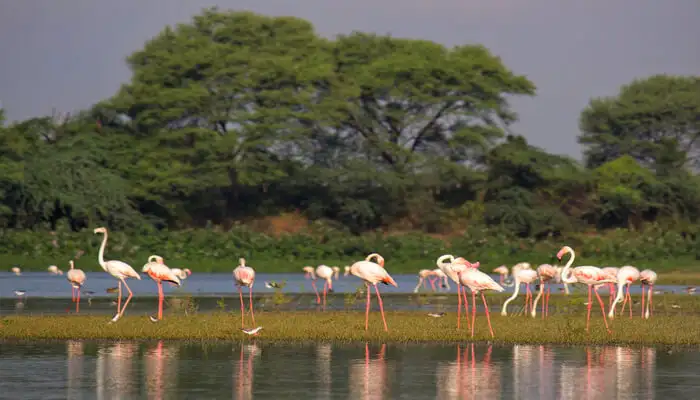Sundarban National Park: Discover The World’s Largest Delta And Its Biodiversity Hotspot

Sundarbans National Park West Bengal -
Sundarbans National Park is a UNESCO World Heritage Site located in the Ganges, Brahmaputra, and Meghna rivers delta in the Bay of Bengal. It is the largest mangrove forest in the world and home to a unique ecosystem that supports a diverse array of flora and fauna.
The park covers an area of 10,000 square kilometers, of which 60% is in Bangladesh, and 40% is in India. It is named after the abundant Sundari trees in the area, and it is a popular destination for nature lovers, wildlife enthusiasts, and adventure seekers.
The Sundarbans National Park is home to the majestic Bengal Tiger, one of the largest predators on earth. The park is also home to various other wildlife, including saltwater crocodiles, Indian pythons, chital deer, and spotted deer. It is also an important breeding ground for numerous species of birds, such as kingfishers, eagles, and storks.
Apart from its wildlife, the Sundarbans National Park also boasts a rich cultural heritage, with a significant population of indigenous people living in the area. The park is also known for its unique geography, with numerous interconnected waterways and tidal creeks.
This article will delve deeper into the Sundarbans National Park, exploring its history, geography, biodiversity, and cultural significance. We will also provide practical information on how to get there, the best time to visit, and what to expect during your trip. So, let’s begin our journey to this fascinating natural wonderland.
Location of Sundarban National Park-
Sundarbans National Park is located in the Indian state of West Bengal, in the southern part of the Sundarbans delta in the Bay of Bengal. The park is situated in the South 24 Parganas district and covers an area of approximately 1,330 square kilometers. The park is part of the Sundarbans Reserve Forest, the largest mangrove forest in the world, and is spread across India and Bangladesh. The park is situated about 100 kilometers from Kolkata, the capital city of West Bengal, and can be accessed by road and waterways.
Best Time to Visit Sundarbans National Park: A Seasonal Guide-
Sundarbans National Park is a unique and magnificent biosphere reserve located in the delta of the Ganges, Brahmaputra, and Meghna rivers along the Bay of Bengal in India. The park is home to the world’s largest mangrove forest, with a rich biodiversity of flora and fauna, including the famous Bengal tiger. However, to fully enjoy the beauty of this place, it is important to plan your visit during the right season. In this article, we will guide you through the best time to visit Sundarbans National Park, with a seasonal guide to help you plan your trip.
- Winter Season (October to February): The winter season in Sundarbans National Park is the best time to visit the park, as the weather is mild and comfortable. The temperature during this time ranges from 10 to 30 degrees Celsius, making it ideal for wildlife spotting and outdoor activities. The cool breeze and clear skies offer a great view of the park’s flora and fauna. Moreover, it is also the best time for birdwatching, as the park hosts a variety of migratory birds during this time.
- Summer Season (March to June): The summer season in Sundarbans National Park is hot and humid, with temperatures ranging from 25 to 40 degrees Celsius. The weather during this time can be challenging for wildlife sightings as animals retreat into the forest to avoid the heat. However, it is an excellent time for tiger spotting, as the vegetation is sparse, and the tigers are more visible near the water sources. Additionally, this season is ideal for river cruising, as the water levels in the delta are high, making it easier to navigate.
- Monsoon Season (July to September): The monsoon season in Sundarbans National Park is characterized by heavy rainfall and high humidity, making it challenging to explore the park. However, this season is a great time for nature enthusiasts, as the park comes alive with lush greenery, blooming flowers, and active wildlife. The riverine network in the delta is at its peak during this time, making it an excellent time for boating and spotting aquatic wildlife, including crocodiles, dolphins, and otters.
The best time to visit Sundarbans National Park depends on your interests and preferences. If you want to enjoy the park’s flora and fauna, the winter season is the ideal time. However, the summer season may be a better option if you are interested in tiger spotting or river cruising. Finally, if you love the monsoon season’s vibrant and lush greenery, plan your visit during the monsoon season. With this seasonal guide, you can plan your visit to Sundarbans National Park and have an unforgettable experience.
How to Reach Sundarbans National Park: A Comprehensive Travel Guide-
Sundarbans National Park is a popular tourist destination located in the delta region of West Bengal, India. It is home to a diverse range of flora and fauna, including the Royal Bengal Tiger, making it a must-visit for wildlife enthusiasts. If you plan a trip to Sundarbans National Park, you must know how to reach this remote and exotic destination. Here’s a comprehensive travel guide to help you get to Sundarbans National Park.
By Air: The nearest airport to Sundarbans National Park is Netaji Subhas Chandra Bose International Airport in Kolkata, around 112 kilometers away. You can hire a taxi or take a bus from the airport to reach Godkhali, the entry point of Sundarbans National Park.
By Train: The nearest railway station to Sundarbans National Park is Canning Railway Station, 48 kilometers away. You can hire a taxi from the railway station or take a bus to reach Godkhali, the entry point of Sundarbans National Park.
By Road: Sundarbans National Park is well-connected by road, and you can take a bus or hire a taxi from Kolkata to reach Godkhali. From Godkhali, you can take a motorized boat to get to the national park.
By Water: The only way to reach the core area of Sundarbans National Park is by boat. From Godkhali, you can hire a motorized boat to take you to the national park. Several options are available for boat rides, ranging from small wooden boats to larger, air-conditioned ferries.
It’s important to note that the journey to Sundarbans National Park can be quite arduous, and planning your travel well in advance is best. Also, hiring a guide to help you navigate the park and spot wildlife is advisable.
Sundarbans National Park Safari: A Wildlife Adventure-
Sundarbans National Park, located in West Bengal, India, is a UNESCO World Heritage Site and one of the largest mangrove forests in the world. The park is known for its unique ecosystem, rich biodiversity, and the majestic Royal Bengal Tiger. A Sundarbans National Park Safari is an exciting way to experience the park’s wildlife and natural beauty up close.
The park offers several safari options to visitors, including boat safaris, jeep safaris, and walking safaris. Each safari has its advantages and allows visitors to explore different park areas. Boat safaris are the most popular and offer visitors the best chance of spotting the Royal Bengal Tiger and other wildlife.
During the boat safari, visitors can see a wide variety of animals, including crocodiles, deer, monkeys, and several species of birds. The highlight of the safari is undoubtedly the Royal Bengal Tiger, which can be spotted in the park’s various tiger reserves.
Jeep safaris are another popular option for visitors exploring the park’s interiors. Jeep safaris allow visitors to explore the park’s dense forests and grasslands, which are not accessible by boat. Walking safaris are ideal for those who want to get close to the park’s flora and fauna. However, walking safaris are only allowed in some park regions and are subject to rules and regulations.
Visitors can also opt for a night safari, which is a unique experience. A night safari allows visitors to see nocturnal animals not visible during the day, such as fishing cats, jungle cats, and civets.
The best time to go on a Sundarbans National Park Safari is between September and March when the weather is pleasant and dry. However, visitors should remember that the park is closed during the monsoon season from June to August.
Before embarking on a safari, visitors must obtain the necessary permits and follow park rules and regulations. Visitors are also advised to carry insect repellent, sunblock, and appropriate clothing and footwear.
Accommodations at Sundarbans National Park: A Complete Guide-
If you’re planning a visit to Sundarbans National Park, it’s important to consider where you’ll be staying. The park offers a variety of accommodations, ranging from luxury resorts to simple guesthouses. Here’s a complete guide to the different types of accommodations available in and around the park:
Forest lodges: The park offers several forest lodges located inside the park. The forest department runs these lodges and offers basic amenities such as beds, electricity, and hot water. Some famous forest lodges in Sundarbans are Sajnekhali, Sudhanyakhali, Dobanki, and Netidhopani.
Wildlife resorts: If you’re looking for a more luxurious stay, several wildlife resorts are located around the park. These resorts offer a range of amenities such as air-conditioned rooms, swimming pools, and in-house restaurants. Some popular wildlife resorts in Sundarbans are Sunderban Tiger Camp, Tiger Roar Resort, and Sundarbans Jungle Camp.
Guesthouses: If you’re on a budget, several guesthouses and homestays are located in the nearby villages. These guesthouses offer basic amenities such as beds, shared bathrooms, and home-cooked meals. Some popular guesthouses in Sundarbans are Supti Tourist Lodge, Bonbibi Tourist Lodge, and Pakhiralay.
Houseboats: Another unique accommodation option in Sundarbans is houseboats. These boats offer a chance to stay on the water and explore the mangrove forests. Houseboats have basic amenities such as beds, toilets, and a kitchen. Some of the popular houseboats in Sundarbans are MV Chhuti, MV Paramhamsa, and MV Bonbibi.
No matter your budget or preference, plenty of accommodation options are available in and around Sundarbans National Park. It’s important to book in advance, especially during the peak season, to ensure availability.
Things to Do and See at Sundarbans National Park: An Excursion Guide-
Sundarbans National Park is home to a rich diversity of flora and fauna, including the Royal Bengal Tiger, saltwater crocodile, spotted deer, and many species of birds. Here are some of the top things to do and see at Sundarbans National Park:
- Wildlife Safari: A wildlife safari is a must-do activity at Sundarbans National Park. You can take a boat tour, or a motorboat ride deep into the mangrove forests to spot Royal Bengal Tigers, saltwater crocodiles, spotted deer, and other wildlife.
- Bird Watching: Sundarbans is home to various birds, including the white-bellied sea eagle, osprey, kingfisher, and many more. You can go bird watching in the park to spot these beautiful birds.
- Visit the Sajnekhali Watchtower: The Sajnekhali Watchtower is a popular attraction in the park. It is an excellent spot for wildlife viewing and birdwatching. You can also visit the Mangrove Interpretation Centre located near the watchtower.
- Visit the Netidhopani Watchtower: The Netidhopani Watchtower is another popular attraction in the park. It is an excellent spot for wildlife viewing and offers stunning views of the surrounding landscape.
- Visit the Bhagabatpur Crocodile Project: The Bhagabatpur Crocodile Project is a breeding and research center for saltwater crocodiles. You can visit the project to learn about the conservation efforts being undertaken to protect these endangered species.
- Explore the Mangrove Forest: The mangrove forest is a unique ecosystem; exploring it is a fantastic experience. You can take a guided tour through the forest to learn about the different plant species and their role in the ecosystem.
- Visit the Jhingekhali Watchtower: The Jhingekhali Watchtower is an excellent spot for birdwatching and wildlife viewing. It offers breathtaking views of the surrounding landscape and is a must-visit attraction in the park.
- Visit the Sudhanyakhali Watchtower: The Sudhanyakhali Watchtower is another popular attraction in the park. It is an excellent spot for wildlife viewing, especially Royal Bengal Tigers and spotted deer.
These are just some of the many things to do and see at Sundarbans National Park. The park is a unique destination and offers a one-of-a-kind experience for nature lovers and wildlife enthusiasts.
Sundarban National Park Flora And Fauna-
Sundarbans National Park is known for its unique and diverse flora and fauna. It is home to many plant and animal species, many of which are endangered or rare.
Flora: The Sundarbans is primarily a mangrove forest, with over 64 species of mangroves. The most dominant species is the Sundari tree, which gives the forest its name. Other commonly found trees include Gewa, Keora, Dhundal, Kankra, and Golpata. The forest floor is covered with a thick layer of mud, which supports a variety of grasses and shrubs.
Fauna: The Sundarbans are home to many animal species, including the Royal Bengal Tiger, the park’s star attraction. Apart from the tiger, other major animal species in the area include Estuarine Crocodile, Indian Python, Fishing Cat, Leopard Cat, and Wild Boar. The park is also a birdwatcher’s paradise, with over 250 bird species, including the Brahminy Kite, White-bellied Sea Eagle, and Pallas’s Fish Eagle.
The park is also home to several species of reptiles, including snakes and turtles. The Gangetic River Dolphin is another important species found in the Sundarbans.
Conservation Efforts at Sundarbans National Park: A Sustainability Insight-
Many conservation efforts have been put forth to protect the wildlife and ecosystem of the Sundarbans National Park. One of the main initiatives is the Sundarbans Biosphere Reserve, which was established in 1989. It covers 9,630 square kilometers, including the Sundarbans National Park and the adjacent regions.
The Sundarbans Biosphere Reserve is home to a diverse range of flora and fauna, including 334 plant species, 49 mammal species, 315 bird species, 55 reptile species, and 8 amphibian species. The reserve is also home to over 120 fish species and numerous invertebrates.
To protect wildlife, the government of India has set up several protected areas, including wildlife sanctuaries and national parks. Forest rangers and other officials closely monitor these areas to prevent poaching and other illegal activities.
Additionally, various NGOs and conservation organizations work to protect the Sundarbans National Park. Some of these organizations work to educate locals about the importance of conservation and sustainable use of resources. Others work to prevent illegal activities, such as logging and poaching.
In recent years, there has been growing concern about the impact of climate change on the Sundarbans National Park. Rising sea levels and increased salinity in the water threaten to destroy the delicate ecosystem of the mangrove forest. To address these concerns, India’s government has initiated several measures, including the construction of sea walls and the promotion of sustainable tourism.






